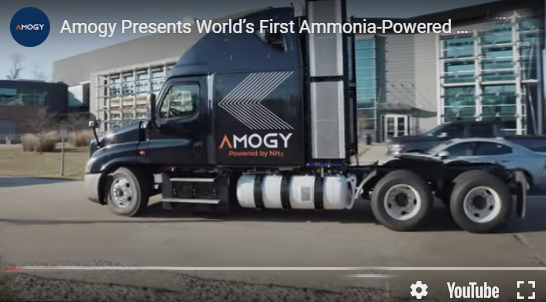|

08
June 2023
By Brian Wang
Amogy Inc., a pioneer of emission-free, energy-dense ammonia power
solutions, announced today the successful testing of the first-ever
ammonia-powered, zero-emission semi truck. Amogy has received $150
million in funding.
The system has 5x higher system-level energy densities compared to
lithium batteries. The volumetric energy density of liquid ammonia is
almost 3x greater than that of compressed hydrogen. Over an equivalent
distance, fueling a vehicle solely using ammonia would require
approximately three times the internal tank volume needed for
conventional diesel fuel but three times less than the volume required
for compressed hydrogen.

Portable
It’s easy to store. Although ammonia is a gas at ambient temperatures,
it can be stored as a liquid at approx. -34°C (-29°F). This reduces
the cost, complexity, and space requirements for storage compared with
liquid hydrogen and liquefied natural gas (LNG). At an ambient
temperature, ammonia can also be stored as a liquid with only mild
pressure.
Tens of millions of tons of ammonia is used in the agriculture sector
as a fertilizer. Ammonia production, transport and usage already have
the technological maturity, infrastructure, and familiarity of the
public to expand in the transportation sector.
The shipping industry accounts for approximately 3% of global CO2
emissions. The sector is largely dependent upon oil-derived fuels such
as heavy fuel oil (HFO), very low sulfur fuel oil, and marine gas oil
(MGO) to meet its energy needs. Together these fuels represent
approximately 221 million tons of oil demand per annum. Liquefied
natural gas (LNG) accounts for a smaller proportion of shipping fuel
demand, with 2.3 million tons of the fuel consumed in 2021. The only
low carbon fuels deployed beyond pilot project scale are marine
biofuels, which make up less than 0.1% of the sector’s fuel supplies,
according to the International Energy Agency (IEA).
Ammonia is compatible with more than one ship propulsion technology.
In smaller ships, it can be used as a hydrogen carrier for fuel
cell-based electric propulsion systems, where an onboard cracker
splits ammonia to provide the hydrogen source. In larger vessels,
where energy density or efficiency considerations mitigate against
fuel cell technologies, it may be suitable for injection into adapted
internal combustion engines (ICEs). Use within ICEs entails relatively
minor alterations to the layout of propulsion systems in comparison
with fuel cell adoption. However, due to ammonia’s narrow flammability
range, the shipping industry envisions using the fuel in combination
with a smaller quantity of ignition fuel—either MGO or hydrogen
extracted from the ammonia using a cracker. Two leading engine
manufacturers, Wärtsilä and MAN Energy Solutions, have already
announced plans to introduce ammonia-fueled combustion engines to
market by 2024.
Trucking
Road freight is a vital component of economic activity. The pandemic
highlighted the sector’s importance as an increasing number of trucks
were deployed to deliver products to end consumers. Guidehouse
Insights forecasts the global fleet of heavy duty vehicles to reach 94
million by 2030, up 30% from 2020’s estimated 74 million. Most of this
growth is expected to come from developing markets. Trucks currently
make up around 87% of the heavy duty vehicles market and represent one
of the fastest growing segments. However, trucks also represent a
transport segment that is in dire need of decarbonization. In 2021,
medium- and heavy duty trucks emitted 1.8 gigatons (Gt) of CO2,
thereby accounting for 23% of all transport-related emissions and 9%
of global carbon emissions.
Green Play Ammonia™, Yielder® NFuel Energy.
Spokane, Washington. 99212
509 995 1879
Cell, Pacific Time Zone.
General office:
509-254
6854
4501 East Trent
Ave.
Spokane, WA 99212
|